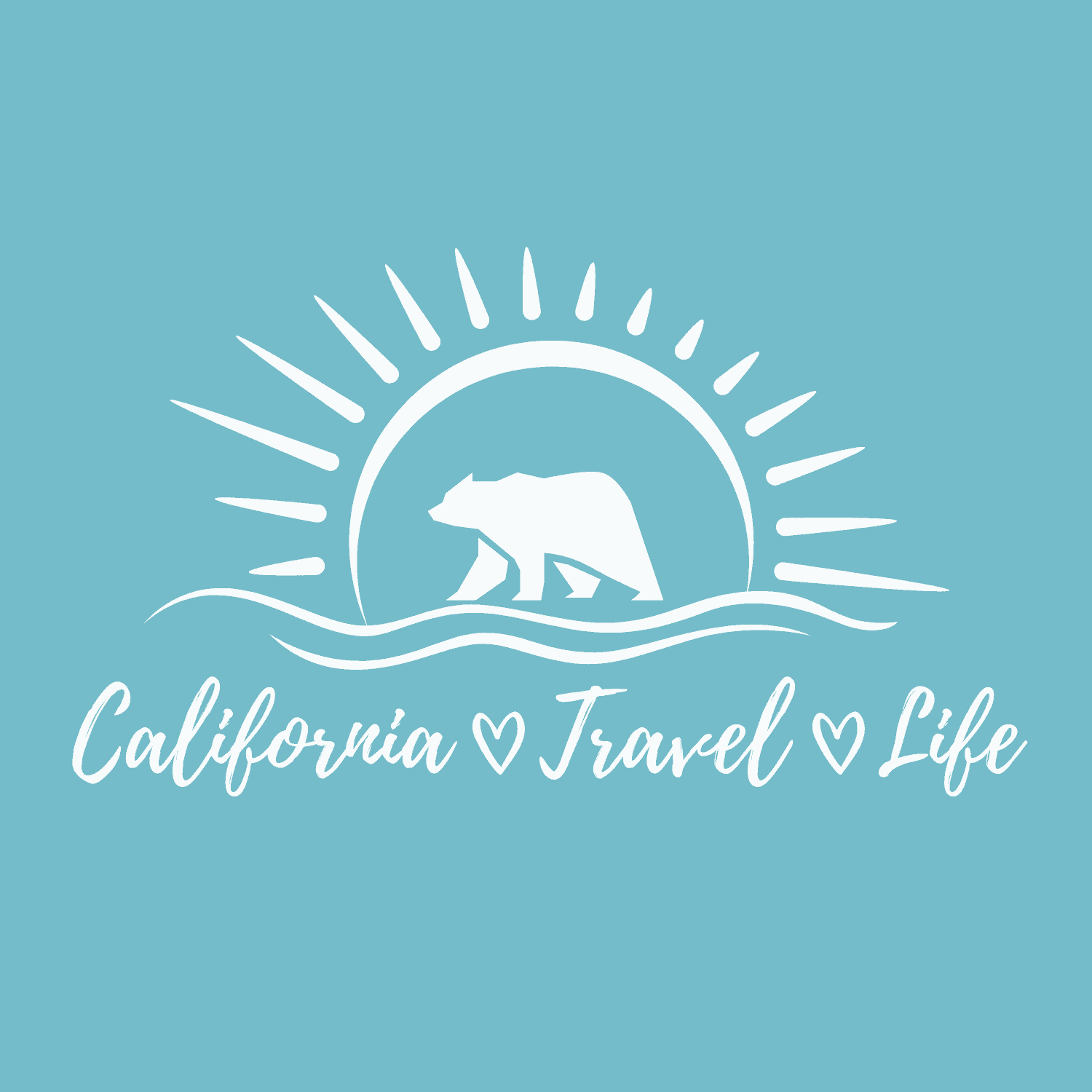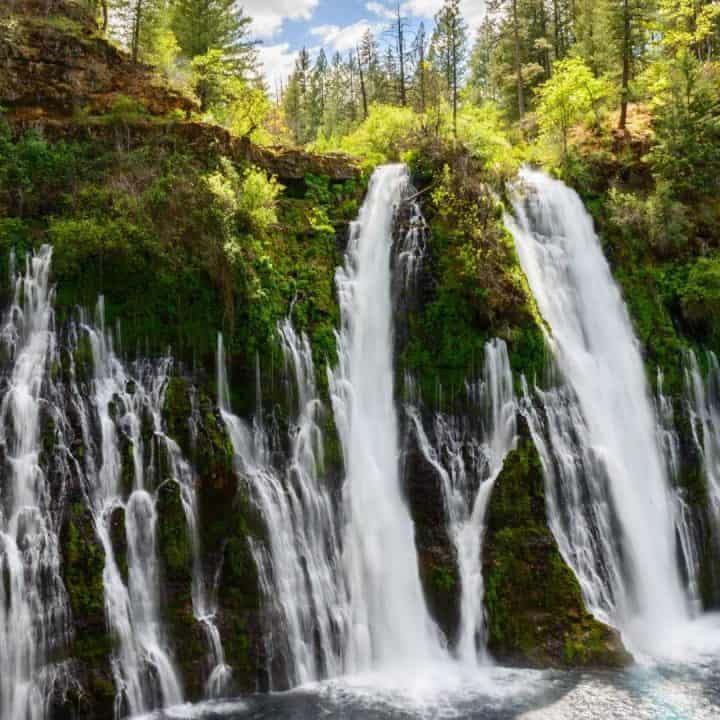There are several amazing waterfalls in Northern California, including the tallest in all of North America! Northern California is home to towering mountains and ample rivers, which means water has to fall from time to time.
While many of the best waterfalls in Northern California are located in national parks, they can also be found close to urban areas, in remote corners of the state, and even on the beach!
Here are 20 Northern California waterfalls that deserve a spot on your bucket list along with details about what it takes to see each one.
22 Best Waterfalls in Northern California
1. Burney Falls
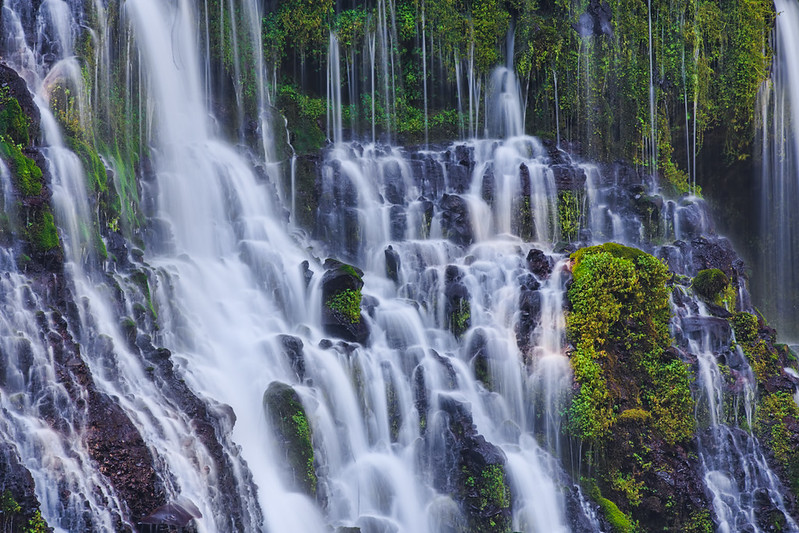
Tucked up in Northeastern California is McArthur-Burney Falls Memorial, home to a set of falls so impressive tha Teddy Roosevelt once deemed them “the eight wonder of the world”.
Burney Falls are fed by an underground spring. The waterfall emerges through dozens of holes in the cliff, dropping 129 feet in an ethereal display.
It is a short and easy walk from the parking lot to the viewing area for the falls. There is also a one-mile loop trail which is nice to walk. It offers a different perspective of the falls and is a nice way to stretch your legs.
Lake Britton is also located in this state park and is a great place to camp or enjoy water sports and fishing during the summer.
Admission to the state park is $10.
Best time to visit this Northern California waterfall: Burney Falls flows all year and is lovely no matter what time you visit. The falls are especially beautiful when the area foliage is turning colors in the autumn. The busiest season is summer and parking can become an issue by midday.
2. McCloud Falls
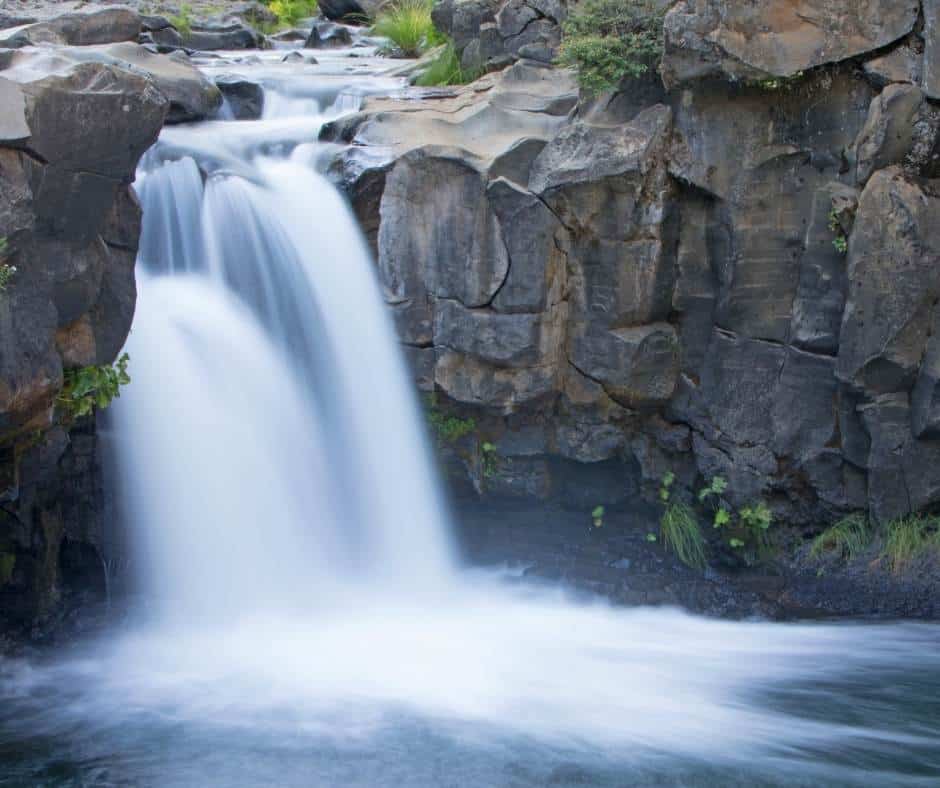
The Mount Shasta region is home to some great waterfalls. McCloud Falls are located less than 20 miles from the town of Mt. Shasta, and visiting them is easy while traveling on Insterstate 5.
McCloud River Falls are actually three separate waterfalls which are all interconnected by an easy, four-mile (round trip) trail. During the summer months, the pools below these waterfalls are fun places to swim.
Jumping from the 15-foot lower falls was a popular activity in the past, but now it is strongly discouraged because large submerged rocks have moved into the area, making it extremely dangerous.
Middle McCloud Falls is the most impressive. It is about 50 feet tall and 100 feet wide. Upper Falls is still quite beautiful and worth the walk. It is 30 feet tall and typically the least crowded for swimming.
Best time to visit this Northern California waterfall: Summer is a great time to visit if you want to get in the water, but know it can get busy when the weather is warm. Spring and fall are great options if you want fewer crowds and don’t care about swimming. Winter is subject to snow.
3. Mosbrae Falls
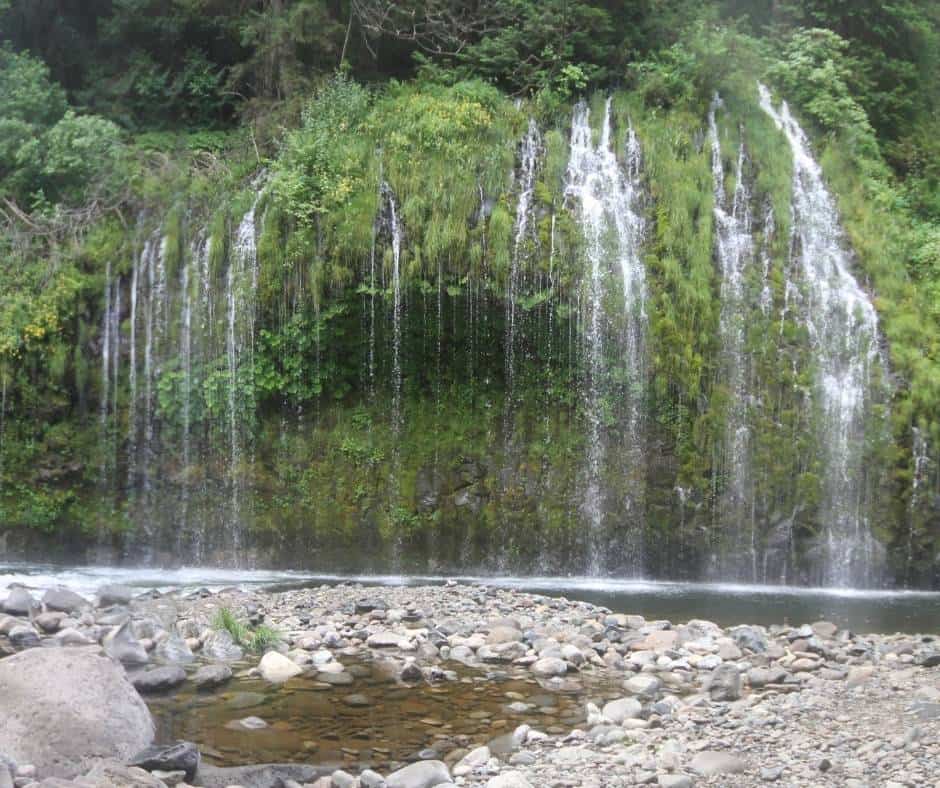
Another waterfall in the Mount Shasta region that you will definitely want to check off you “waterfalls in Northern California bucket list” is Mosbrae Falls in Dunsmuir.
This lush and elegant waterfall is formed when pure spring water pours out of the moss-covered cliffside into the Sacramento River.
Here is the problem with Mosbrae Falls- it requires that people walk along the train tracks (which are private property) in order to access them and this is considered trespassing.
Thousands of people walk along the tracks to Mosbrae Falls every year, but unfortunately someone did get hit by a train once so be aware that there is risk involved if you don’t stay off the tracks. Here is the full skinny on hiking along the tracks to Mosbrae Falls.
Thankfully, the city of Dusnmuir has been working with the Mount Shasta Trail Association to build a trail that connects Hedge Creek Falls with Mosbrae Falls. They are actively taking steps forward to build the trail, but it saeems like it is still in the “red tape phase”.
It is currently a 0.6-mile round trip walk to Hedge Creek Falls which are next to the Sacramento River.
Hedge Creek Falls are small and the water flow is slight during low water years. But if you take the trail past the falls, you cross the river which is typically 1-2 feet deep in the height of summer. The water is quite cold but popular for swimming.
After you cross the river and walk a short distance down the tracks you will come to Mosbrae Falls which never disappoints.
Best time to visit this Northern California waterfall: It is best to come in the summer if you are planning on crossing the Sacramento River to reach Mosbrae Falls. If you do choose to follow the tracks, just avoid the snowy season.
4. Potem Falls

Want more Shasta area waterfalls? How about one that drops 70 feet down into the Pit River which eventually become an arm of Lake Shasta?
This waterfall lies in a deep canyon. The swimming hole at the bottom of Potem Falls can’t be beat during the summer months, and you don’t want to forget to check out the rope swing.
So how does one access this wonderful waterfall? The good news is that the hike is only 0.4 miles. It is narrow in spots and can be a bit slippery near the bottom so be careful and have fun!
You will have to drive on a dirt road for about 10 miles to get to the trailhead but the road is well maintained.
Best time to visit this Northern California waterfall: You can visit this waterfall anytime of year (weather permitting) but summer is best if you want to swim.
5. Feather Falls
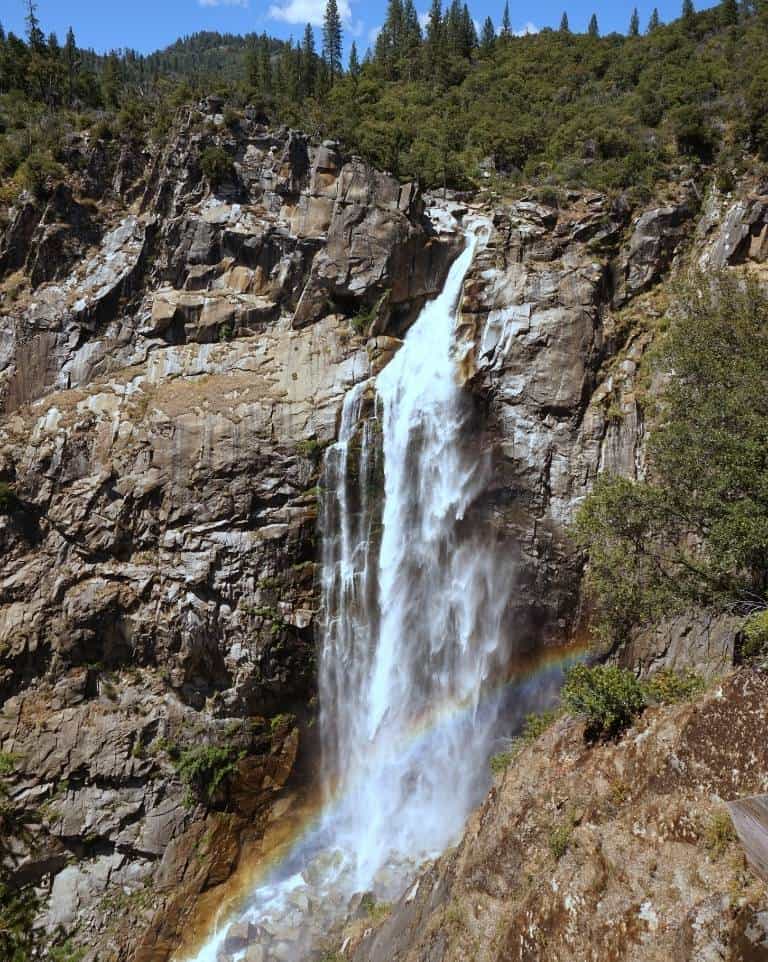
Feather Falls once claimed to be “the sixth tallest waterfall in the United States” at 640 feet, but recent measurements have put it more accurately at 410 feet.
Still, 400+ feet is impressive and this waterfall is surely one of the best in Northern California. It is located near Lake Oroville in the Plumas National Forest.
Sadly, the area around Feather Falls was ravaged by the North Complex fire in 2020. According to the California Wilderness Coalition, “It burned 318,935 acres of public and private forest lands, destroyed 2,352 structures and wiped out the small mountain communities of Berry Creek and Feather Falls, and killed at least 15 people.”
Before the fire, Feather Falls was accessed via an 8-mile loop trail. This trail will likely be closed for a few years until crews have had time to clear debris, fix portions of the trail that have been damaged by uprooted trees, and rebuild the viewing platform for the falls.
Save this waterfall for a visit once the trail is reopened and you will be able to witness a forest regenerating.
Best time to visit this Northern California waterfall: Once the trail has been reopened, the best time to visit is April and May when waterflow is at its most robust.
6. Kings Creek Falls

Kings Creek Falls is a waterfall located in Lassen Volcanic National Park, one of the more underrated national parks in California.
This 40-foot waterfall is accessed via a 2.5-mile round trip trail (choose from an out and back or a loop option). Unlike many waterfall hikes, the walk to the waterfall is downhill. This means you will have to hike back up 500 feet in elevation on the way back to the trailhead.
Thankfully, much of the trail follows the creek and there are several small waterfalls to enjoy along the way.
Best time to visit this Northern California waterfall: You can only access the road which leads to the trailhead when it has been cleared of snow. This is typically mid-June through October. The waterfalls flow will be higher in June than October, but it does flows all year.
Mount Lassen National Volcanic Park made our list of the best Northern California weekend getaways. See what other special spots we recommend.
7. Mill Creek Falls
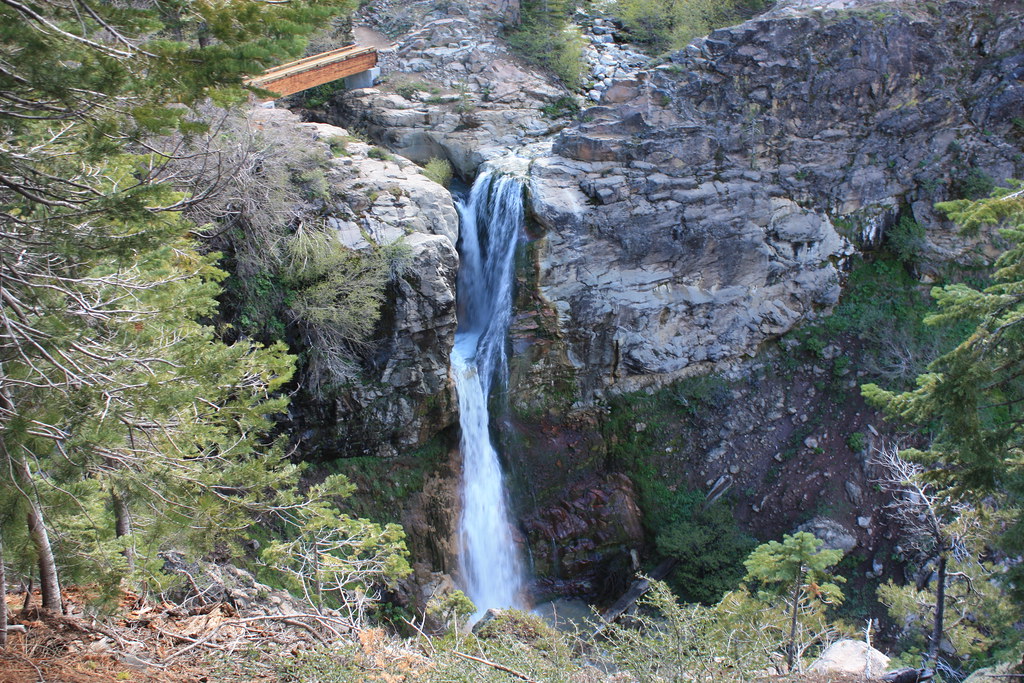
Lassen Volcanic National Park is home to another waterfall hike that you won’t want to miss. Mill Creek Falls is the tallest waterfall inside the national park with a drop of 75 feet.
Accessing this waterfall requires a couple creek crossings and lots of ups and downs on the trail along the way but anyone reasonably fit should have no issues on the 3.8-mile (round trip) trail. Much of the hike is forested and there are colorful wildflowers along the trail in early summer.
Mill Creek Falls is just below the confluence of Sulphur Creek and Bumpass Creek. Bumpass Creek comes from the active geothermal area of Bumpass Hell within the park, so don’t be surprised if you catch a whiff of rotten egg smell thanks to the sulphur in the water.
Best time to visit this Northern California waterfall: You want to visit when the snow has melted and the wildflowers are in bloom. Late June is an ideal time to see Mill Creek Falls.
8. Whiskeytown Falls
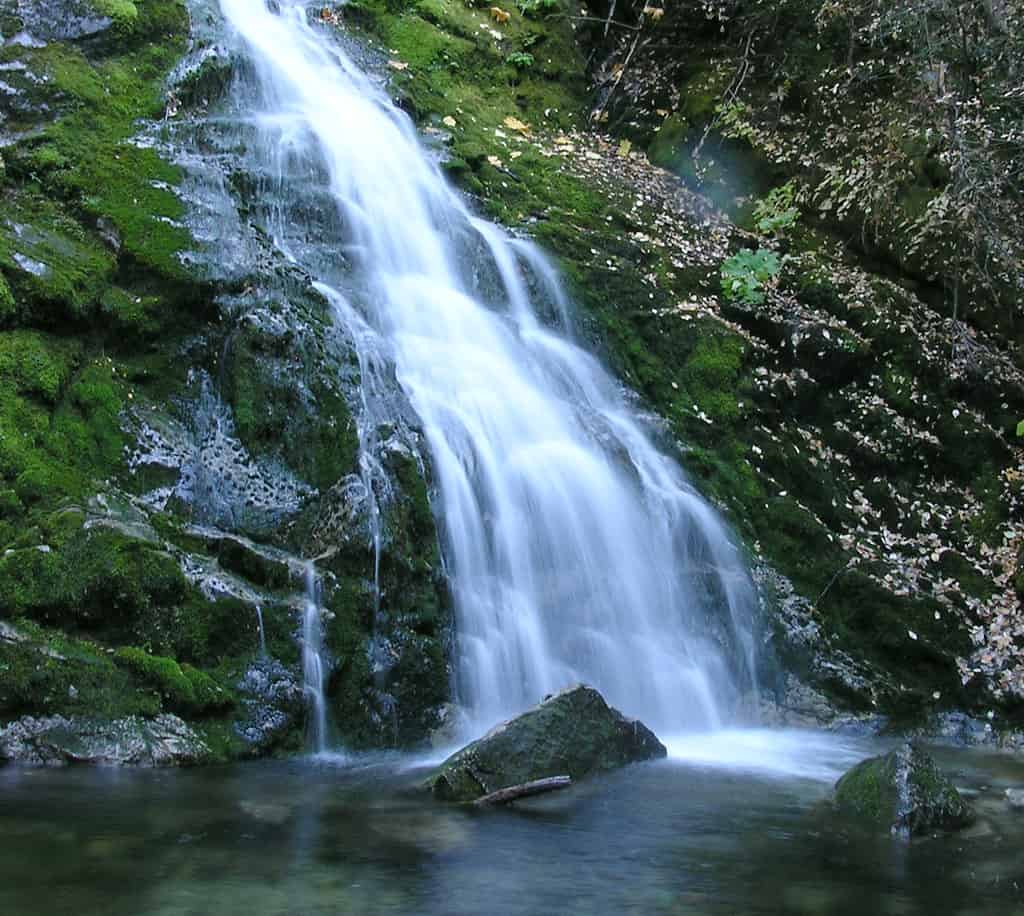
Whiskeytown National Recreation Area, west of Redding, is home to several different waterfalls, including the recently rediscovered (in 2004) Whiskeytown Falls.
How does a 220 foot waterfall hide in a popular recreation area for decades? Well, the simple answer is that the area was previously owned by a logging company so it was on private property.
Then, the land became national park service land, but the park rangers who knew about the waterfall back in 1967 when it was acquired kept it quiet because they didn’t have the staff or money at that time to protect the waterfall.
Those who knew about the falls either passed on or moved on, and it wasn’t until 2004 when park resource managers rediscovered the Whiskeytown Falls. They secured funding and built a trail to the falls, which has now been open for 15 years.
Today, you can enjoy this waterfall if you are willing to hike 2.7 miles round trip and battle the steep, uphill climb along the way. The trail gains over 750 feet in elevation in about 1.3 miles, but trust me, the waterfall is worth it.
Best time to visit this Northern California waterfall: It is best to visit Whiskeytown Falls from May to October because the weather can make things challenging during the rest of the year. Temps can be very hot in the summer, so it is best to get an early start.
9. Codfish Creek Falls

If you are looking for an enjoyable waterfall hike within daytrip distance of Sacramento, look no further than the easy hike along the North Fork of the American River to Codfish Creek Falls.
This trailhead is accessed off Interstate 80 near Weimar on a dirt road that can be steep and bumpy in spots, but is well worth the effort. An SUV or 4WD is definitely recommended, but I once watched a friend (barely) make it her passenger car. I would avoid the road when it is muddy.
The trail to the waterfall follows the American River through the canyon for 1.4 miles before reaching 68-foot Codfish Creek Falls. The falls are a two drop cascade which you can get right next to.
There is a bridge that crosses the river and it is a popular spot for swimming and jumping. There is also often a rope swing hanging from the bridge.
Note: There is a fee to park at the trailhead.
Best time to visit this Northern California waterfall: The trail along the American River is a nice hike anytime it isn’t raining or hasn’t recently rained (due to the rough road). Fall has less water but pretty autumn color. Spring has the best water flow and summer is ideal for swimming.
10. Ukunom Falls
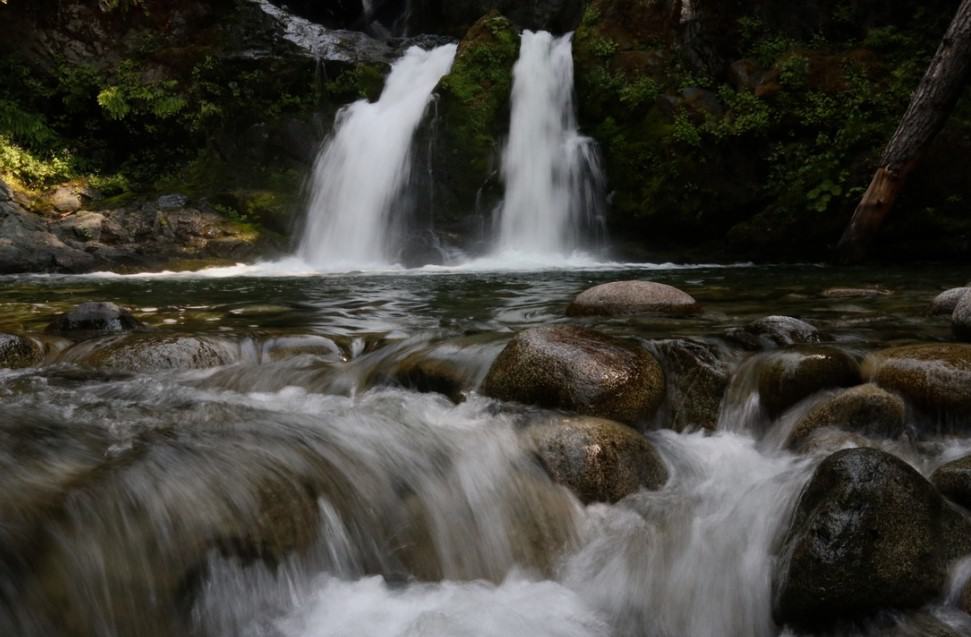
Way up near the Oregon border lies remote mountain town of Happy Camp on the Klamath River, about 70 miles west of the nearest city of Yreka. It is the land of tall trees and wild rivers, making it no surprise that it is a popular river rafting destination.
See why Happy Camp made our list of our favorite California mountain towns.
Ukonom Creek is a clear creek that feeds into the Klamath River about 18 miles from Happy Camp and is home to Ukonom Falls, a pair of 25-foot waterfalls that are great for swimming under and around during the summer months.
You can reach the falls via a three-mile, out-and-back hike that gains 1,500 feet in elevation along the way, but the most popular option is to visit them as part of a river rafting side trip. Several different operators in the area offer excursions to these lovely falls.
Best time to visit this Northern California waterfall: Summer and early fall are the best times to visit this waterfall. It will be far too cold to swim during the winter and spring runoff can be dangerous on heavy snow melt years.
11. Alamere Falls

I have highlighted several waterfalls in Northern California that are located near the mountains, so how about one that flows directly onto the beach?
Many know about McWay Falls along the Big Sur coast in Central California but far fewer know about California’s second tidefall, Alamere Falls in Point Reyes National Seashore.
This waterfall that drops 40 feet onto the sand below has gained more notoriety in recent years thanks to Instagram. An un-sanctioned “shortcut” has also become popular, but it is very dangerous and not recommended. The park reports injuries caused by attempting the shortcut every week.
Instead, make a full day of it and take a magical 13.8-mile journey past lakes, through the forest, and enjoying incredible ocean vistas until you reach one of only four tidal waterfalls in the country.
It is essential that you start your hike early in the day (before 8am to ensure parking) and pay attention to tide charts so you don’t caught in high tide.
I suggest making a weekend of it and camping at Wildcat Campground so you don’t have to do the full hike in one day. Just be aware that the campground books up months in advance.
Best time to visit this Northern California waterfall: There really isn’t a bad time to visit Alamere Falls as long as the weather cooperates. You will get the most sunshine in September and October. Spring is great for wildflowers and a heavier waterfall flow.
12. Cataract Falls
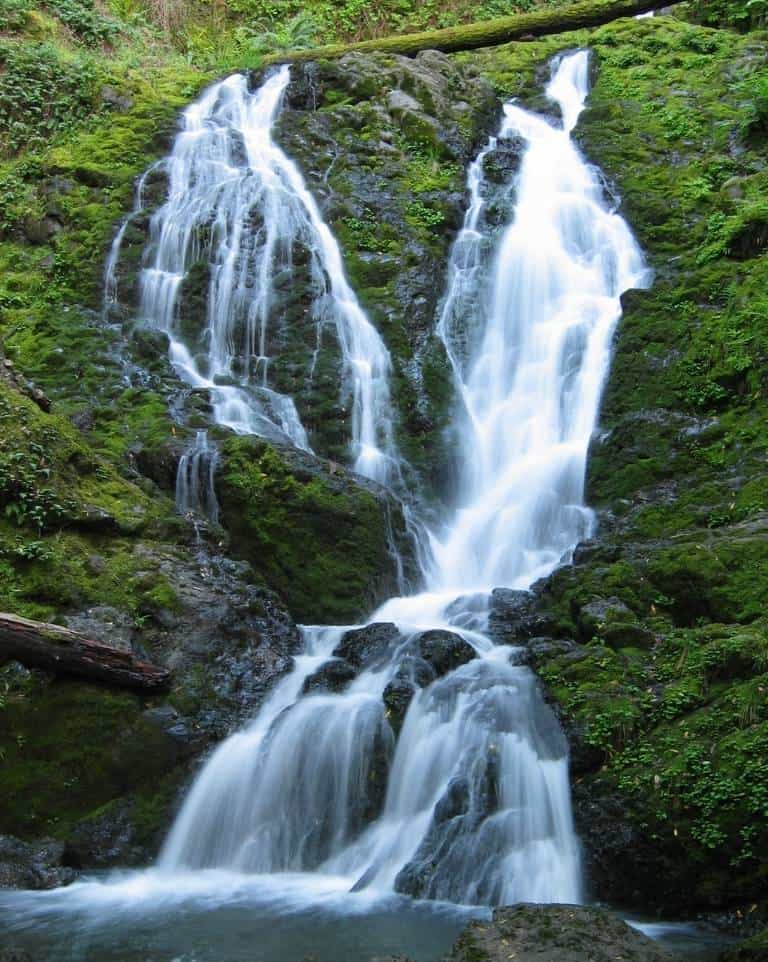
If you are looking for a waterfall hike in the Bay Area, head to Mount Tamalpais in Marin County to follow Cataract Creek to Cataract Falls.
This hike is more about the journey than the destination. Cataract Falls are nice, but the series of waterfalls you pass while walking through a lush forest of redwoods and ferns are what makes this spot so special. There are several cascades along Cataract Creek to enjoy.
This is classic coastal Northern California scenery packed into a moderate, 2.8-mile trail. There are several sets of stairs along the way as trail does climb about 1,000 feet up the side of Mt. Tam.
The trail begins at Alpine Lake and ends at picnic tables along Cataract Creek, a perfect spot to enjoy a snack. This trail is extremely popular due to its proximity to a major urban area (and immense beauty) so arrive early to secure a parking spot at the trailhead.
Best time to visit this Northern California waterfall: The water flows best after storms which typically occur in the winter and spring.
13. Root Creek Falls

Castle Crags State Park in the far northern reaches of California is known for its dramatic granite peaks. I have always thought they look a little bit spooky and mystic.
The Crags are popular with rock climbers and hikers alike. Root Creek Falls is a stunner of a waterfall, tumbling 500 feet over a series of drops in a granite chute with the impressive Castle Dome looming in the background.
Accessing this waterfall requires a 3.2-mile hike. Most of it is easy and wheelchair accessible, but the last 1/2 mile to the falls requires a bit of a scramble up the south side of the creek on a lesser maintained trail at the end.
Park at the Vista Point parking area inside the state park. Begin on the Crag Trail until you reach the split for the Root Creek Trail. Then make your way up the Root Creek Trail. When this trail ends, follow a less maintained trail to the left of the creek up the canyon until you reach the falls.
The area with the best view of the falls can be a bit precarious to access, so watch your footing and be aware of the poison oak in the area.
Best time to visit this Northern California waterfall: March and April are prime time. The water is flowing thanks to the higher elevation snow. The waterfall is dry in the summer.
14. Rainbow Falls
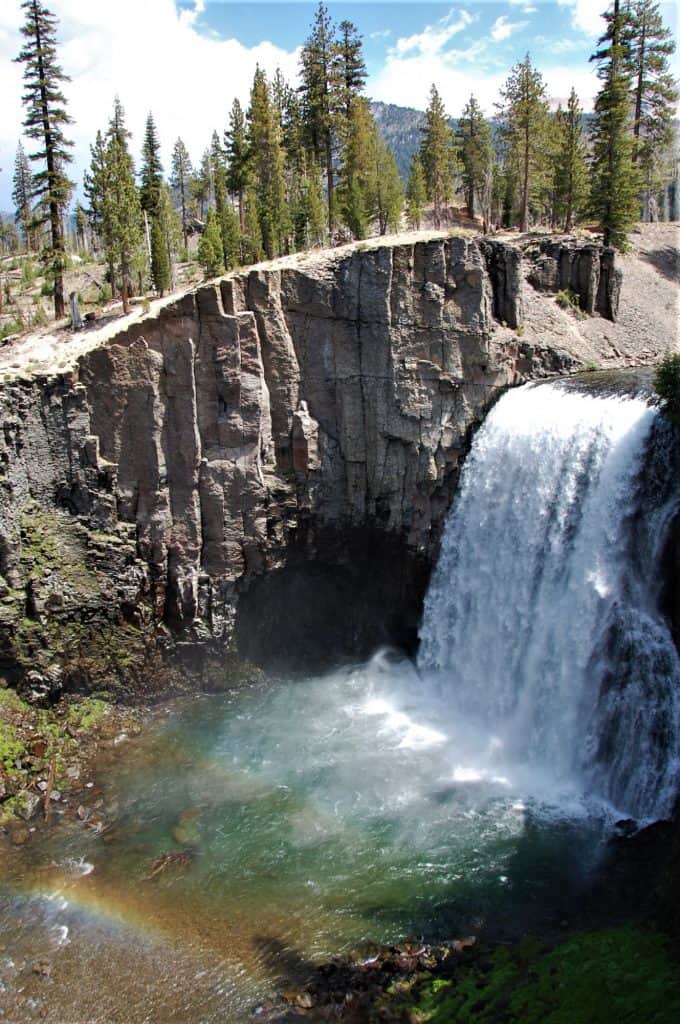
The most impressive waterfall near Mammoth Lakes in the Eastern Sierra and one of my favorite waterfalls in Northern California is Rainbow Falls. This waterfall drops an impressive 101 feet and there is often a rainbow or two at its base when the sun is shining.
Rainbow Falls is located in Devil’s Postpile National Monument, which protects an impressive geological wonder that is made up of hexagonal basalt columns that are 60 feet tall. They were created by a volcanic eruprion 100,000 years ago.
The road down to Devil’s Postpile and Rainbow Falls is closed due to snow for a good chunk of the year. It is usually open from around mid-June to mid-October. During the summer, visitors must park at the Mammoth Adventure Center and take a shuttle down to the trailheads.
If you visit when the road is open but the shuttle is not yet operating, try to arrive early in the morning because the parking lots will be full by 8 or 9am.
It takes less than a mile to hike to Devil’s Postpile, and Rainbow Falls is a little more than 1.5 miles futher. Take time to enjoy the falls and then double back until you reach the spur trail to Red’s Meadow.
Finish your hike with an ice cream cone at Reds Meadow Resort, a popular destination for Pacific Crest Trail backpackers. You can pick up the shuttle back to your car from here. The entire hike is about 4.5 miles.
Best time to visit this Northern California waterfall: Unless you are up for a long hike down a closed road through the snow to the trailhead, you need to visit Rainbow Falls when the road is open. September will be the least busy time to do that, but the water flow will be stronger earlier in the summer.
Several of the best waterfalls in Northern California are located inside Yosemite National Park. There are many impressive cascades throughout the park’s 750,000 acres. Here are some of the most scenic and accessible.
15. Lundy Canyon Falls
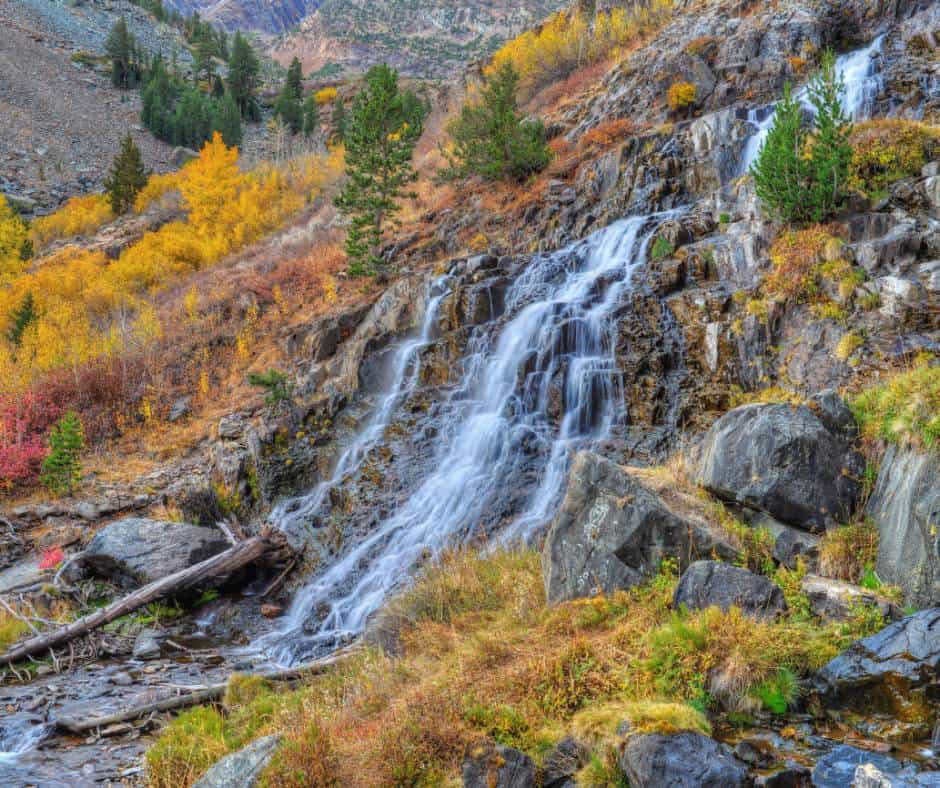
Lundy Falls are located in gorgeous Lundy Canyon located near Lee Vining in the Eastern Sierra Nevadas. The trailhead up Lundy Canyon to the falls is about 4.6 miles round trip with a moderate, 600-foot elevation gain. There is some rocky terrain and a couple steep sections along the way, but nothing too difficult.
The Lundy Canyon Falls are actually a series of cascading waterfalls surrounded by lush forests of pine and aspen trees, which are especially lovely in the fall during the color change and early summer during wildflower season. In all, there are 4-5 cascades, depending on your definition of waterfall.
16. Yosemite Falls
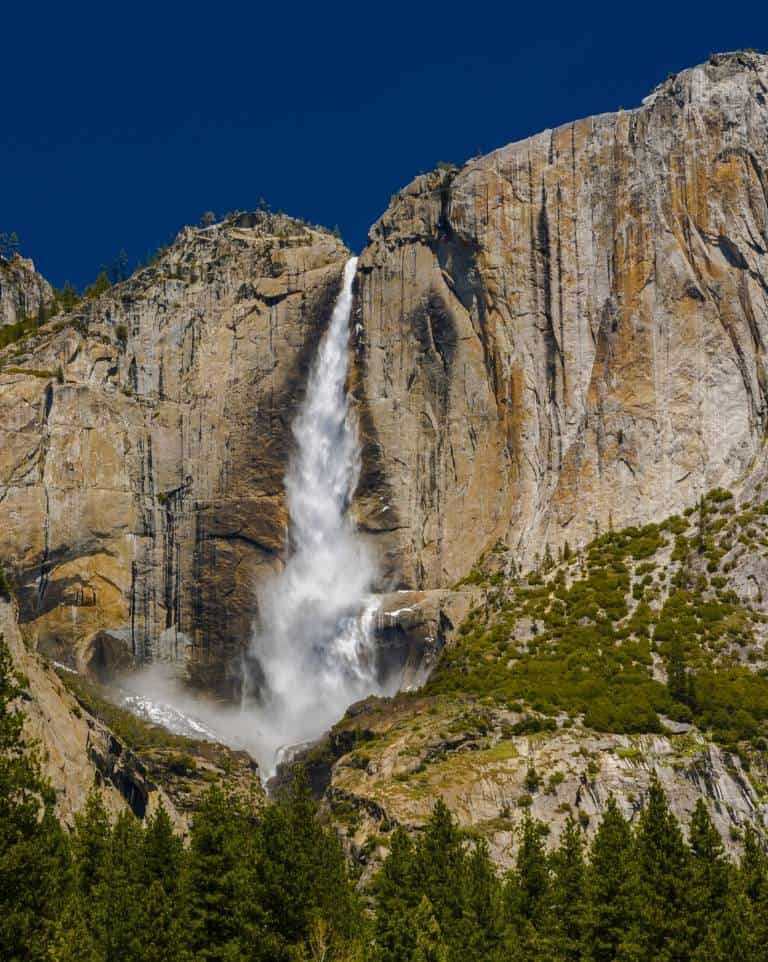
Yosemite Falls is not only one of the most impressive waterfalls in Northern California, it is also the tallest in North America. This set of falls cascades 2,425 feet over sheer granite cliffs down to Yosemite Valley.
It is easy to spot Yosemite Falls from several locations throughout the Valley, including Sentinel Meadow and Yosemite Village, but the best way to see them is to get close to the base of Lower Yosemite Falls and feel the spray coming off the thundorous falls in late spring.
You can also hike to the top of Yosemite Fall,s but be prepared for a strenuous, all-day adventure. The hike is only 7.2 miles round trip but it gains an impressive 2,700 feet along the way!
Best time to visit this Northern California waterfall: May and early June are the best times to see Yosemite Falls because this is when snowmelt is at its peak. The deeper the snowpack, the stronger and longer the falls will flow. In many years, the falls are nothing more than a skinny trickle by August.
Plan your Yosemite adventure with our Yosemite Day Trip Itinerary.
17. Vernal Fall
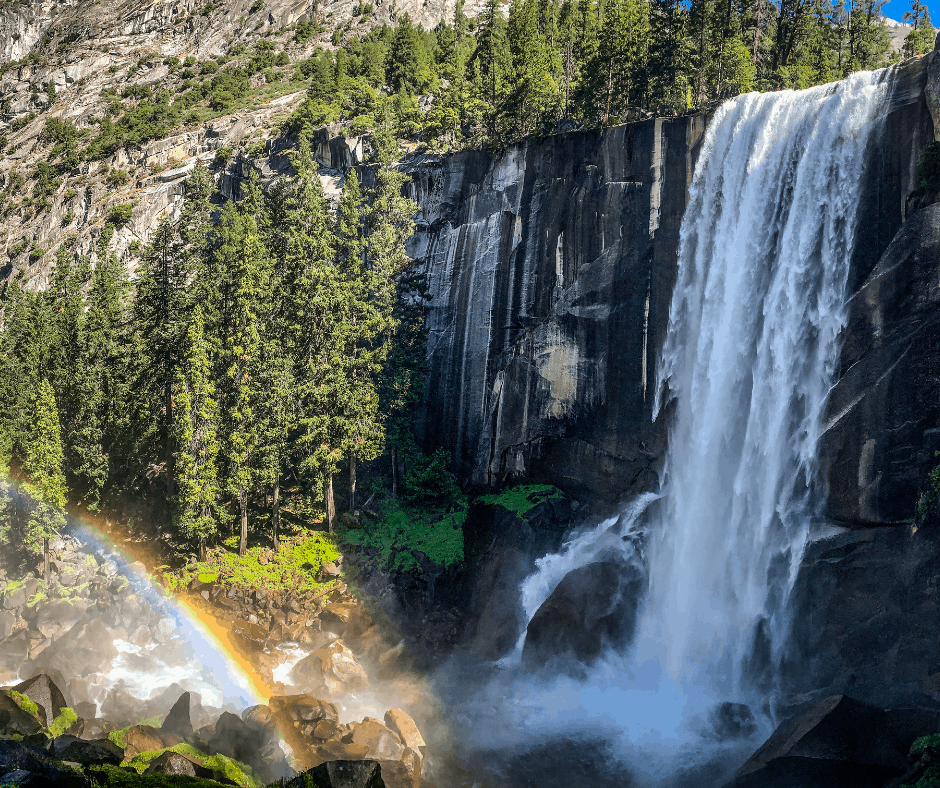
Vernal Fall is the first waterfall you will come to when hiking on the popular Mist Trail in Yosemite National Park. Alternatively, you can also access Vernal Fall from the John Muir Trail.
The waterfall drops 317 feet in a lovely cascade which is sure to get you wet with its spray as you climb the steps of the trail (now you know where the trail gets its name!).
You can choose to view Vernal Fall from the footbridge which is about 0.8 miles from the Mist trailhead, or choose to hike to the top of Vernal Fall, gaining 1,000 feet over 1.2 miles.
Best time to visit this Northern California waterfall: Vernal Fall does run year round, but as with most Yosemite waterfalls, it is at its peak in late spring.
18. Nevada Fall
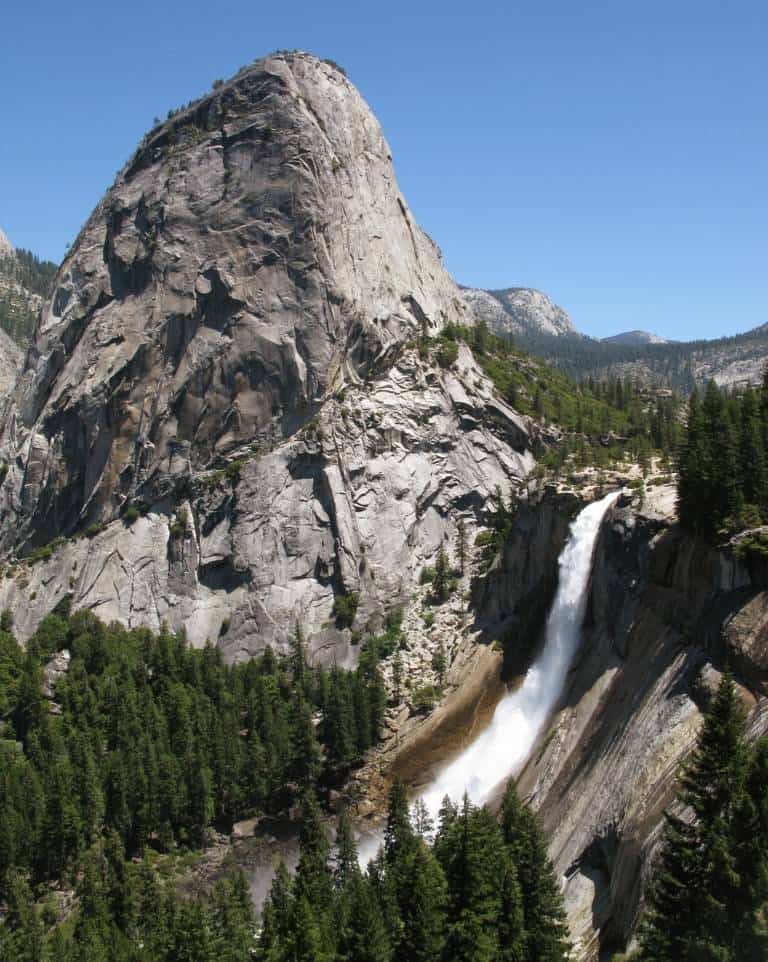
About 1.6 miles beyond Vernal Falls is Nevada Falls, another impressive Yosemite waterfall that drops nearly 600 feet. It is accessed via the Mist Trail or the John Muir Trail.
The total distance to the top of Nevada Fall and back is 5.4 miles on the Mist Trail, gaining 2000 feet in elevation along the way. I suggest taking the Mist Trail up to Nevada Fall and the John Muir Trail back down to create a lovely loop.
If you aren’t up for a hike, you can catch a distant view of both Vernal Fall and Nevada Fall from Glacier Point.
Best time to visit this Northern California waterfall: Nevada Fall doesn’t ever dry up, but it has its highest water volume in late spring.
19. Bridalveil Fall
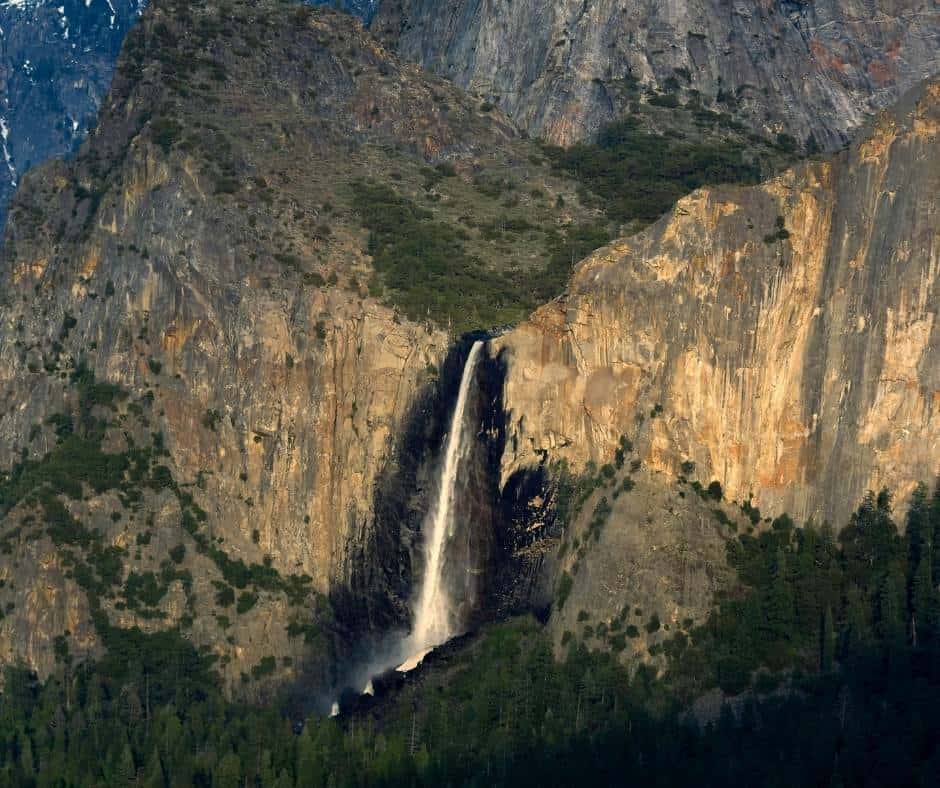
Bridalveil Fall is the first waterfall you see when you get that first majestic view of the Yosemite Valley at Tunnel View near the edge of the valley. It is a waterfall that flows all year long, falling 620 feet in an elegant single drop.
It is an easy to walk to the base of the waterfall from the parking lot on the short, 1/4-mile trail. It made our list of the best easy hikes in Yosemite National Park.
Best time to visit this Northern California waterfall: There isn’t a bad time to visit Bridalveil Fall since it flows nicely year round, but it is typically at its peak in late May.
20. Wapama Falls

Relatively few people make there way over to Hetch Hetchy, a beautiful valley 15 miles from Yosemite Valley that was dammed and filled with water from the Tuolumne River to support the people of San Francisco’s water needs.
It was the only time in history that a city was allowed to develop a national park for their exclusive use. Sadly, the Raker Act was signed in 1913, despite massive public outcry lead by conservationist John Muir.
The fight to remove O’Shaughnessy Dam continues today thank to groups like Restore Hetch Hetchy. In the meantime, it is still a nice place to explore, and home to a few different waterfalls, including Wapama Falls.
Wapama Falls cascades 1100 feet over three distinct cascades. It is one of the most distinct features in Hetch Hetchy Valley and during the heavy rain years, the flow can be so high that it flows over the footbridge, making further passage on the trail impossible.
Most of the year, it flows at a reasonable rate, though in spring you can expect to get wet on the footbridge.
The trail to Wapama Falls is an easy, 5.5-mile (round trip) journey, with just 200 feet in total elevation gain.
Best time to visit this Northern California waterfall: Visit in spring if you want to see this waterfall at its best. Just check trail conditions ahead of time because after major rains some of the stream crossings on the trail may be too difficult.
21. Sentinel Falls

Some of Yosemite’s waterfalls only make limited appearances. Sentinel Falls is one such waterfall, only flowing from March through June.
Still, Sentinel Falls drops an impressive 2,000 feet into the Yosemite Valley which means it had to make our list of waterfalls in Northern California that you don’t want to miss.
This waterfall is located on the south side of the Valley, near Sentinel Rock. Instead of one big drop, it is made up of several different cascades.
You can best see this waterfall from the Sentinel Beach Picnic Area or when hiking the trail to Upper Yosemite Falls.
Best time to visit this Northern California waterfall: March through June. The waterfall is very seasonal and only makes an appearance in the spring.
22. The Horsetail Falls Firefall
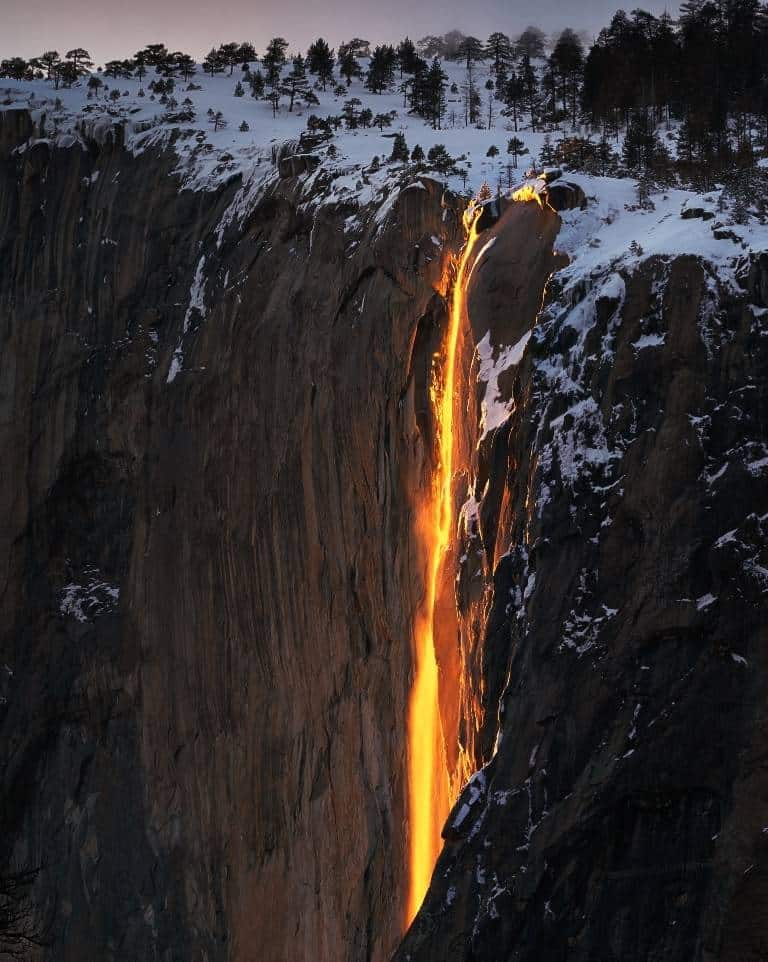
One of the most legendary waterfalls in Northern California is the famed firefall in Yosemite National Park.
The firefall is created when the glow of the sunset hits 1,000-foot Horsetail Fall during mid to late February. For a few brief moments, the water looks like it is on fire, a sight that those who have witnessed it will never forget
This waterfall drops off the east side of El Capitan, the famed granite monlith well-known by rock climbers, from December through April. To see the firefall, park at the El Capitan picnic area and view the waterfall from the road.
There used to be another firefall in Yosemite, made of real fire! In the late 1800s there was a hotel up at Glacier Point and most nights the owner would kick the embers from the night’s campfire over the cliff’s edge, creating a firey display that looked like a flaming waterfall to those below in the valley.
Then, from the early 1900s until 1968, David Curry of Camp Curry fame revived the firefall. Every night at 9PM there was a call up to Glacier Point to “Let the fire fall!” and burning logs would be pushed over the cliff, creating an impressive display.
Eventually the National Park Service ended the practice since it caused large crowds, strained the park’s natural resources, and was not a natural occuring event. Thankfully, you can still enjoy the natural version if you time things right.
Best time to visit this Northern California waterfall: If you want to see the firefall, come mid to late February on a sunny day when there is enough water from a recent rainfall to supply the waterfall.
